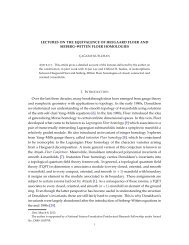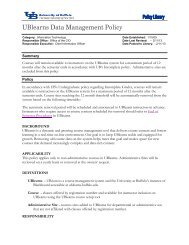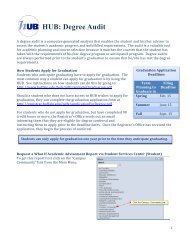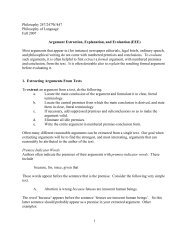Why children are getting and what UB is - University at Buffalo
Why children are getting and what UB is - University at Buffalo
Why children are getting and what UB is - University at Buffalo
You also want an ePaper? Increase the reach of your titles
YUMPU automatically turns print PDFs into web optimized ePapers that Google loves.
James N. Roemmich (left) <strong>and</strong> Leonard<br />
H. Epstein <strong>are</strong> part of a <strong>UB</strong> team examining<br />
ties between high park access<br />
<strong>and</strong> <strong>children</strong>’s physical activity.<br />
should be e<strong>at</strong>en r<strong>are</strong>ly, yellow denotes<br />
moder<strong>at</strong>e-calorie foods th<strong>at</strong> can be e<strong>at</strong>en<br />
occasionally <strong>and</strong> green <strong>is</strong> for low-calorie<br />
foods th<strong>at</strong> can be consumed freely.<br />
It’s th<strong>at</strong> practical approach th<strong>at</strong> <strong>is</strong><br />
central to the work being done by <strong>UB</strong><br />
researchers as they dig deeply into the<br />
habits of young people with weight <strong>is</strong>sues.<br />
Role of the family<br />
A recent <strong>UB</strong> study showed th<strong>at</strong> by using<br />
a device th<strong>at</strong> restricts video viewing time<br />
on TVs <strong>and</strong> computers, p<strong>are</strong>nts could cut<br />
the time spent on video games an average<br />
of 17.5 hours a week. Also, the <strong>children</strong>’s<br />
body mass index (BMI) was significantly<br />
lower by the end of the two-year study.<br />
(BMI <strong>is</strong> a calcul<strong>at</strong>ion of one’s weight to<br />
height.)<br />
“Results show th<strong>at</strong> w<strong>at</strong>ching telev<strong>is</strong>ion<br />
<strong>and</strong> playing computer games can lead to<br />
obesity by reducing the time th<strong>at</strong> <strong>children</strong><br />
<strong>are</strong> physically active, or by increasing the<br />
amount of food they consume as they<br />
engaged in these sedentary behaviors,”<br />
Epstein reports.<br />
“Our tre<strong>at</strong>ments take a family<br />
approach, <strong>and</strong> show strong rel<strong>at</strong>ionships<br />
between child <strong>and</strong> p<strong>are</strong>nt behavior <strong>and</strong><br />
weight change. When we comp<strong>are</strong> child<br />
<strong>and</strong> p<strong>are</strong>nt weight change, our d<strong>at</strong>a suggest<br />
th<strong>at</strong> it <strong>is</strong> easier for <strong>children</strong> to lose<br />
[weight] <strong>and</strong> maintain weight loss than<br />
their p<strong>are</strong>nts, as they have not had the<br />
unhealthy behaviors as long as their p<strong>are</strong>nts,”<br />
Epstein explains.<br />
“P<strong>are</strong>nts <strong>are</strong> extremely powerful role<br />
models for the e<strong>at</strong>ing <strong>and</strong> exerc<strong>is</strong>e habits<br />
of their <strong>children</strong>—not only ‘<strong>wh<strong>at</strong></strong>’ <strong>and</strong> ‘how<br />
much’ they e<strong>at</strong>, but also their rel<strong>at</strong>ionship<br />
to physical appearance, food, physical<br />
activity <strong>and</strong> overall health,” says Salvy.<br />
“P<strong>are</strong>nts can set the occasions for physically<br />
active activities with peers/friends<br />
<strong>and</strong> family members.”<br />
Still, there <strong>are</strong> roadblocks when trying<br />
to motiv<strong>at</strong>e youth with weight <strong>is</strong>sues to be<br />
more physically active.<br />
“The increase in obesity <strong>is</strong> likely due, in<br />
part, to changes to our home <strong>and</strong> neighborhood<br />
environments th<strong>at</strong> have influenced<br />
access to <strong>and</strong> choices to be active<br />
or sedentary,” says James N. Roemmich,<br />
associ<strong>at</strong>e professor of pedi<strong>at</strong>rics <strong>and</strong><br />
exerc<strong>is</strong>e <strong>and</strong> nutrition sciences. “I have<br />
become especially interested in how the<br />
environment—such as the physical layout<br />
of neighborhoods—affects <strong>children</strong>’s<br />
weight-control choices.”<br />
Eric frick<br />
In general terms, according to<br />
the Centers for D<strong>is</strong>ease Control <strong>and</strong><br />
Prevention, “overweight” <strong>and</strong> “obesity”<br />
“<strong>are</strong> both labels for ranges of weight th<strong>at</strong><br />
<strong>are</strong> gre<strong>at</strong>er than <strong>wh<strong>at</strong></strong> <strong>is</strong> generally considered<br />
healthy for a given height. The terms<br />
also identify ranges of weight th<strong>at</strong> have<br />
been shown to increase the likelihood of<br />
certain d<strong>is</strong>eases <strong>and</strong> other health problems.”<br />
According to Laychock, “no one really<br />
underst<strong>and</strong>s <strong>wh<strong>at</strong></strong>’s driving obesity [in<br />
both <strong>children</strong> <strong>and</strong> adults]—it <strong>is</strong> a multifactorial<br />
problem.” Are the causes overe<strong>at</strong>ing,<br />
genetics, learned behavior, the endocrine<br />
system, too much stress or a combin<strong>at</strong>ion<br />
of some or all of these factors? <strong>UB</strong><br />
researchers <strong>are</strong> working to unravel th<strong>is</strong><br />
complic<strong>at</strong>ed question.<br />
And with a body of work th<strong>at</strong> spans 20<br />
years <strong>and</strong> a team th<strong>at</strong> includes both medical<br />
doctors <strong>and</strong> scient<strong>is</strong>ts with PhDs, “<strong>UB</strong><br />
researchers have had an impact on the<br />
<strong>is</strong>sue,” Laychock says.<br />
Sarah-Jeanne Salvy, ass<strong>is</strong>tant professor<br />
of pedi<strong>at</strong>rics, Div<strong>is</strong>ion of Behavioral<br />
Medicine, agrees. “It will take a while<br />
to tackle all the factors involved in th<strong>is</strong><br />
epidemic—there <strong>is</strong> some work to do <strong>at</strong><br />
the level of the individual <strong>and</strong> their close<br />
system [family, peers, friends], <strong>and</strong> also in<br />
terms of public health policies. However, I<br />
have no doubt th<strong>at</strong> some of these solutions<br />
will origin<strong>at</strong>e from the research of my colleagues,”<br />
Salvy says.<br />
“Our work continues to develop on<br />
multiple levels,” explains Leonard H.<br />
Epstein, chief, Div<strong>is</strong>ion of Behavioral<br />
Medicine, Department of Pedi<strong>at</strong>rics in the<br />
<strong>UB</strong> School of Medicine <strong>and</strong> Biomedical<br />
Sciences.<br />
“We <strong>are</strong> very interested in genetics of<br />
food reinforcement <strong>and</strong> obesity; the role<br />
of different behavioral, dietary <strong>and</strong> activity<br />
approaches to tre<strong>at</strong>ment; <strong>and</strong> how habits<br />
develop. Our work <strong>at</strong>tempts to transl<strong>at</strong>e<br />
the newest basic science into effective<br />
clinical interventions,” adds Epstein, who<br />
has been involved in childhood obesity<br />
research for 30 years, 15 years <strong>at</strong> <strong>UB</strong>.<br />
In the 1970s, Epstein developed the<br />
Traffic Light Diet, which <strong>is</strong> used in h<strong>is</strong><br />
current research <strong>and</strong> also by health-c<strong>are</strong><br />
professionals around the country. The diet<br />
links food to the three colors of a traffic<br />
light: red indic<strong>at</strong>es high-calorie foods th<strong>at</strong><br />
14 Winter 2009 <strong>UB</strong>TODAY www.alumni.buffalo.edu

















